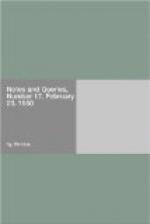Feb. 7. 1850.
Treatise of Equivocation.—I shall feel happy if, through your very opportune medium, I can obtain some information respecting a very extraordinary and mysterious book, as to its existence, local habitation, and any other material circumstance, which has the title of A Treatise of Equivocation. The first recognition of the work is in the Relation of the Proceedings in the Trial for the Powder Plot, 1604. At signat. I. the Attourney-General, Sir E. Coke, appeals to it, and affirms that it was allowed by the Archpriest Blackwel, and that the title was altered to A Treatise against Lying and Fraudulent Dissimulation. He proceeds to describe some of its contents, as if he were himself acquainted with the book. Thomas Morton, Bishop of Lichfield, and Coventry, afterwards of Durham, in his Full Satisfaction concerning a double Romish Iniquitie; Rebellion and Equivocation, 1606, refers to the work as familiarly acquainted with it. (See Ep. Dedic. A. 3.; likewise pages 88 & 94.) He gives the authorship to Creswell or Tresham. He refers likewise to a Latin work entitled Resolutio Casuum, to the same effect, possibly a translation, to which he subjoins the names of Parsons and Allen. Robert Abbot, in his Antilogia, 1613, pp. 13, 14. emphatically and at length produces the same book and facts; but they are merely copied from the Relation of the Powder-treason Trial. Henry Mason, in his most satisfactory work, The New Art of Lying, &c., 1624, has spoken of the {264} Treatise with the same familiarity (see p. 51.), and elsewhere, if my memory does not deceive me. Dodd, in his Church history,—when will the new edition begin to move again? Can Stonyhurst tell?—ascribes the work to Tresham. Hardly any of the similar works in these times belong to one author. It may just be added, that Parson’s Mitigation contains, perhaps, all the substance of the Roman equivocation, with not much reserve or disguise. It was published in answer to Bishop Morton’s work in 1607. Foulis has, of course, substantially all the above, but nothing more.
Now, the questions which I want to have solved are these:—Was the book ever extant in MS. Or print? Is it now extant, and where? Who has seen a copy? What is its size, date, and extent? Has the Durham Cathedral Library, in particular, a copy? Mr. Botfield might have informed us. In fact, where is any effectual intelligence of the fugitive to be found?
J.M.
Feb. 8. 1850.
* * * * *
REPLIES.
ETYMOLOGY OF “ARMAGH.”




